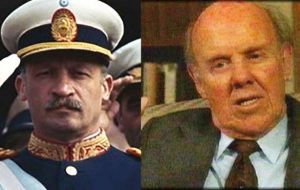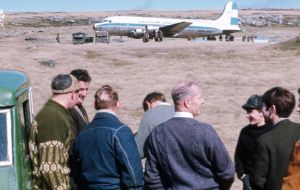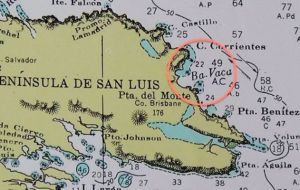MercoPress. South Atlantic News Agency
Falklands' incursion and landing by an Argentine submarine at Cow Bay in October 1966
 Submarine ARA Santiago del Estero, S12, which allegedly was involved in operation Cow Bay
Submarine ARA Santiago del Estero, S12, which allegedly was involved in operation Cow Bay  General Juan Carlos Ongaía, who became military dictator of Argentina in 1966 named Nicanor Costa Mendez as his foreign minister
General Juan Carlos Ongaía, who became military dictator of Argentina in 1966 named Nicanor Costa Mendez as his foreign minister  At the end of September 1966, an Aerolineas Argentinas DC4 force landed in Stanley's race course with a group of high jackers. Coincidence??
At the end of September 1966, an Aerolineas Argentinas DC4 force landed in Stanley's race course with a group of high jackers. Coincidence??  A map of Cow Bay with all the nomenclature in Spanish
A map of Cow Bay with all the nomenclature in Spanish A top-secret operation from the Argentine navy, which apparently took place in October 1966, was revealed by an Argentine newspaper, El Diario Nuevo Día, from the province of Santa Cruz. The operation took place when the submarine ARA Santiago del Estero, emerged at Cow Bay, in East Falkland, north of Stanley, and had a couple of teams land and survey the beach and surrounding areas with most probably a future invasion purpose.
Apparently all those involved received strict orders not to mention a word about the successful operation, and had counterintelligence officers effectively follow them and check not a word was leaked.
For some strange reason or coincidence the operation took place almost at the same time of the Condor crash landing of an Aerolineas Argentinas DC4 passenger plane which left Buenos Aires, heading for Rio Gallegos but was hijacked on flight and forced to head for the Falklands, landing at the race course. This happened on 28 September 1966, and ended with the surrender of the hijackers following the mediation of the local Catholic priest.
But in Buenos Aires since June, a general and commander in chief of the Army, Juan Carlos Onganía had ousted a democratically elected president Arturo Illia and taken his place, naming in his cabinet as foreign minister, Nicanor Costa Mendez, who would also play a crucial role in the 1982 events.
The Cow Beach operation took place at the end of October and according to Mario Novack who wrote the piece, the retired captain Oscar Hector Garcia Rabini who was in charge of the landing and beach surveying finally revealed details of the operation. The operation was instructed by the Argentine Geographic Institute and involved the Submarines Command, at the time under Captain Agustin Cesar Ledesma, and the commander of the submarine Santiago del Estero, Horacio González Llanos.
The submarine captain informed Garcia Rabini that the high command had chosen him and three men of his total trust to train and then with two kayaks row from the Santiago del Estero to Cow Beach for the surveying. They would be equipped for night combat, one day ammunition two-day water and food rations. They would be leaving in three days and the whole operation should be over in fifteen days. Orders were completely secret and so were the consequences.
Garcia Rabini picked the three men who would accompany him, and trained for a couple of days with the German kayaks in the Valdes Peninsula. He was promised a team of tactical divers would be in hand for any emergency.
Following several days sailing, submerged at daytime and surfacing at night the submarine finally reached Cow Beach. The two teams each in a double seated kayak left for shore to collect all possible topographic information and any impediments underwater when approaching the beach
Garcia Rabini recalls they had very specific orders, if they came in contact with locals, police or military personnel, as well as respect for private property and if possible leave no tracks of their incursion. In an extreme scenario they should explain they were in Argentine territory and Argentine citizens, and avoid the use of weapons, except in self defense.
The Argentine officer recalls that when landing and beginning the operation they did manage to see a Falklands' farmer, although they are not certain he saw them, and they were really scared when surprised by an unexpected snorting from a sea elephant close to their position.
On the second landing the nerves of the first night had dissipated and the surveying was completed with no major inconveniences including registering very dangerous currents when approaching the Cow beach. But the mission had been completed successfully and they sailed back to Mar del Plata, and Captain Gonzales Llanos headed for Buenos Aires with the incursion report and survey. Whatever happened with the report, the survey team and Cow Beach personnel involved never were to know.
Garcia Rabini later found out that counterintelligence officers were on their steps to ensure not a word of the mission leaked. He retired from the navy in 1984 and until 1991, he was manager of the Antarctica and Tierra del Fuego hotels, belonging to the Argentine navy in Mar del Plata.
Mario Novack does not explain why the disclosure of the Cow Beach operation now, after almost six decades, but Garcia Rabini recalls seeing the mission order signed by president General Juan Carlos Onganía, foreign minister Nicanor Costa Mendez and the Commander of Naval Operations, Rear Admiral Eugenio Fuenterrosa.




Top Comments
Disclaimer & comment rules-

-

-

Read all commentsOddly enough there were local reports of possible sheep rustling in that area around that time and several farmers began keeping an eye on their coastal beaches.
Oct 19th, 2020 - 10:30 am +2There were other areas reported of potential sheep stealing in the long island area as well.
Maybe Argentina was visiting our shorelines more often than we realised because the mistaken belief was that fishing boats were stealing sheep at night.
One day we may eventually learn the whole truth. Argentina was up to no good around that time and locals were voicing their concerns but no one was listening until 1982 when reality kicked in and finally our concerns were proven correct.
Think
Oct 19th, 2020 - 12:26 pm +2Oh dear is that the best insult you can come up with - you're slipping. Mind you you've probably got a hangover from cheap vodka you Russians make from anti-freeze.
But if you want to see wildlife I would suggest the Blasket Islands - you'll find it on Google Earth
I suppose the only wildlife you get in St Petersburg is the rats!
I don’t think El Diego is a Brit trying to troll, I just think he is mentally deficient.
Oct 19th, 2020 - 03:39 pm +2I can’t say the same to Think, unless he throws racist slurs at me for no reason.
Commenting for this story is now closed.
If you have a Facebook account, become a fan and comment on our Facebook Page!